Do you really need a perfect lawn? And is it sustainable?
The perfect lawn is now a surprisingly controversial issue in gardening.
Some people want a smart, green surface with no flaws. Others say that such a lawn is an ‘ecological disaster.’
Sometimes we are urged to put our mowers away, either for the whole summer or just to mow less. Or we’re urged to do ‘No Mow May’ or similar initiatives to reduce lawn mowing.
So I have asked one of the world’s top lawn experts, David Hedges Gower, Chair of the Lawn Association, to help me sort out what a perfect lawn is. How much work do we really need to do to achieve it? And can we have a traditional lawn while also being environmentally friendly?
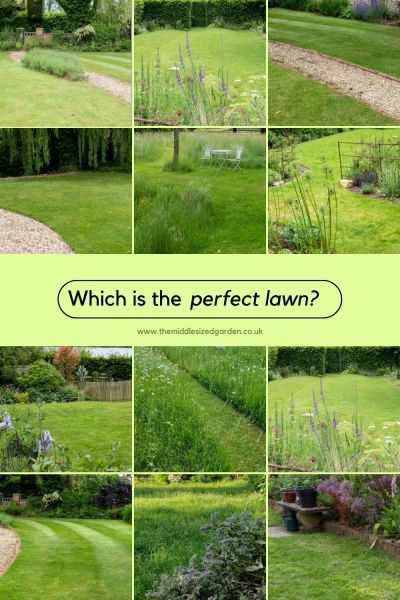
I also wanted to decide which way to go with our own lawn. We left it uncut for 6 weeks during ‘No Mow May’. Should we continue with the wilder look? Or will we regret it further down the line?
So what is a ‘perfect lawn’?
Firstly, David says that you think of the ‘perfect lawn’ as ‘the perfect lawn for you’. And that may – or may not – be mown green stripes.
Gardening is generally a traditional craft, but all traditions need questioning from time to time. Advice that worked for your parents may not work for you, because the world is different or our expectations have changed.
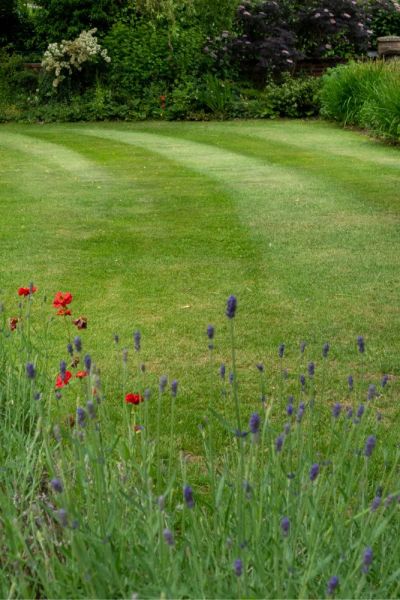
This green and striped 120sq metre lawn in front of David Hedges Gower’s house had an hour of feeding, scarifying and moss control in early spring and is mown weekly. David uses True Grass, an organic fertiliser made from a byproduct of food manufacture. He doesn’t use weedkillers.
Sometimes the old ways are best. At other times, they’re not.
David founded The Lawn Association to provide ‘accurate and modern’ advice on maintaining your lawn. It has a YouTube channel with advice on choosing grasses and lawn care. And they also run lawn care courses for both homeowners and professionals.
David is not a fan of automatically feeding, watering, scarifying, aerating and using moss control on your lawn. He manages four lawns around his house (two belong to neighbours). He only feeds, scarifies, aerates and controls the moss on one of them.
So before you do anything to your lawn because of a gardening ‘to do’ list or ‘top lawn care tips’, he suggests you ‘ask yourself why you’re doing it first.’
What is the best treatment for my lawn?
David says that before you do any treatment on your lawn, decide what you want to achieve.
If you aren’t too bothered by neat stripes and vivid green colour, then you can have a lawn that doesn’t take too much time, effort or money to look after. And it will be environmentally friendly too.
There are essentially four approaches to lawns today.
The traditional perfect lawn – good for keen gardeners
The ‘perfect lawn’ is always very green, moss-free and weed-free. It has neat stripes and tailored edges.
This style of lawn sets off formal gardens and herbaceous borders beautifully. Until recently, it was considered the standard that we should all aim for.
The Lawn Association suggests aerating the lawn in autumn, using hollow tine forks not ordinary garden forks. You can also rent or buy lawn aerating machines, which can do a 250sq m lawn in about twenty minutes. You should also scarify (which chops the grass up as a kind of ‘autumn pruning.’) Add moss control products if you have moss and feed with a fertiliser.
But is the perfect lawn too much work for your lifestyle?
Many people find that this is too much hard work for today’s busy lives.
Others say that such a highly managed lawn uses too much water, chemicals and fuel in mowing or using other machines.
But David Hedges Gower has a 120 sq metre lawn which he keeps to the ‘perfect lawn’ standard. This needs an hour in early spring feeding (using organic fertiliser) and scarifying it, but he doesn’t use herbicides to kill weeds. He also mows this around once a week and never waters it.
This type of perfect lawn is good for people who enjoy gardening. They’re happy to spend time looking after their garden and want it to look its very best.
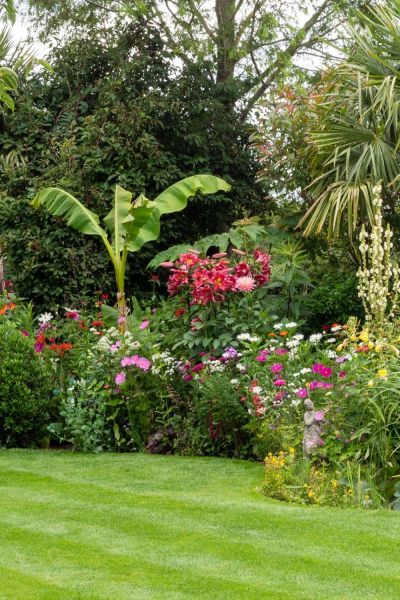
This is Frances and Paul Moskovits smartly edged and striped lawn, which sets off their amazing herbaceous border beautifully. Frances and Paul’s garden is very wildlife friendly, and it is full of birdsong, frogs and more. They keep ‘wild’ areas in corners of the garden. So a ‘perfect lawn’ can work in an environmentally friendly garden. Paul and Frances work hard in their garden, however. It is not low maintenance.
The meadow lawn – the perfect lawn for wildlife-friendly gardens
When I asked wildlife garden landscape expert Joel Ashton for his 5 top wildlife garden tips, one was ‘put the mower away.’
So the second lawn option is to stop mowing, allowing grasses to grow long. These, in theory, turn into meadows, which benefit biodiversity. Meanwhile you don’t spend so much time, money and effort looking after your lawn.
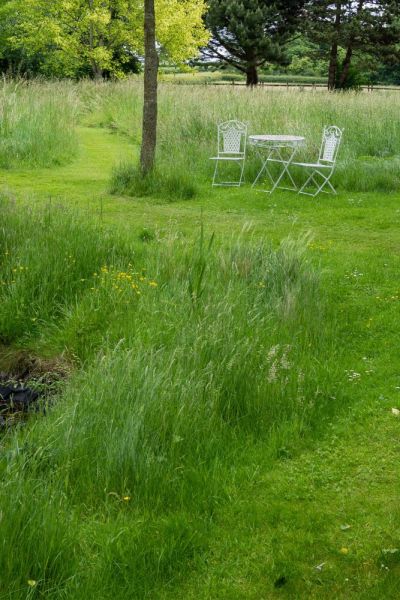
A large area of traditional lawn at the back of David Hedges Gower’s house. He has allowed most of it to grow long. He has mown some paths through it, but otherwise does very little to it.
However, it’s important to recognise that you will have to do some work for this kind of a lawn. You will probably want to weed out pernicious perennial weeds which can take over. You’ll be mowing paths through so that you can walk through it. And it may not suit families whose children want to play games on a lawn.
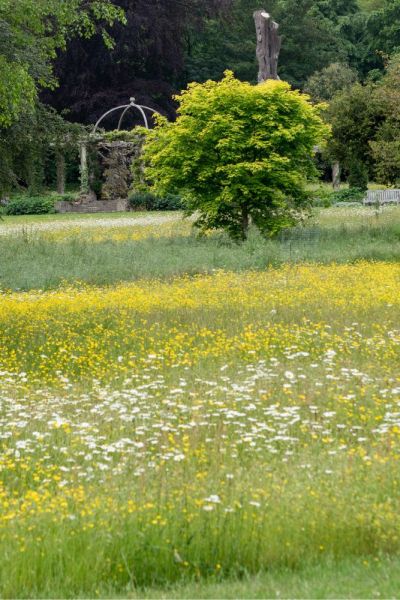
Meadow flowers in grass at West Dean Gardens in Sussex. A few years ago, most big gardens and estates would have mown their grass regularly. Now it is often allowed to grow long so that buttercups and daisies can flourish.
Creating a meadow lawn isn’t always as simple as letting lawn grass grow long, although that can look good. There’s more about creating a meadow lawn in a town garden here.
Many people like to leave just a few patches of grass to grow long, while mowing the main part of the lawn. This can look very pretty.
The ‘nectar lawn’ – is it OK to mow every other week?
A nectar lawn is a more wildlife friendly version of the traditional lawn, because you don’t mow it as often. You don’t use herbicides to kill weeds either. You mow once every two or three weeks to allow small, low flowers such as daisies and clover to flower and feed pollinators.
People often ask if it’s OK to mow every other week. It is, and it creates a nectar lawn.
When you cut it, it returns to looking like a traditional lawn. I first heard about a nectar lawn when I interviewed Jane Moore, author of Planting for Butterflies. We now mow less often, and we never used herbicides on the lawn anyway. (Note that links to Amazon are affiliate, see disclosure).
A nectar lawn does look shaggy in its second or third week compared to a traditionally mown lawn. But it withstands drought a little better.
David Hedges Gower says that mowing less often allows the daisies, clover and other wildflowers to flourish, so the lawn grasses will slowly become less dominant.
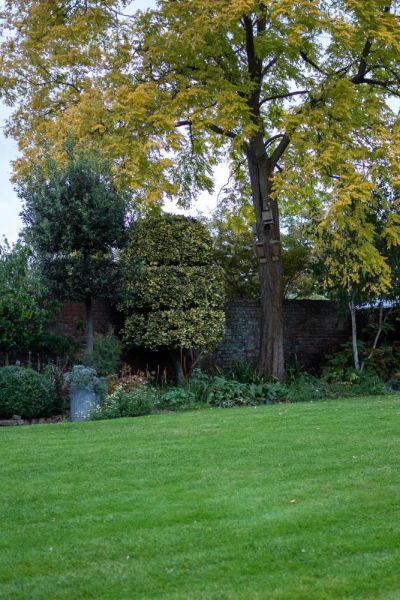
This is our nectar lawn just after mowing. It looks fine, although close up you would see imperfections. But it’s very easy to look after and doesn’t create much work.
My husband mows our lawn. He has adopted the nectar lawn with enthusiasm. This is partly because he would like to increase biodiversity and partly because he does less mowing! Definitely a win-win for him.
He says that most of the work in mowing is taking the grass bag off the mower and throwing the grass in the compost heap. When this mower finally stops working, I think we will buy a ‘mulching mower’ that leaves grass on the lawn to return the nutrition to the soil.
The ‘good enough lawn’ for those who want to save time, effort and money
Many people aren’t hugely interested in their lawn. I admit to belonging in this group. For me, the lawn isn’t the most important part of the garden in terms of how it looks. I’d just like it to look OK and not to be too much trouble. The nectar lawn approach suits us, because it means we spend less time mowing and we are helping wildlife.
But I know that some people feel judged for not having the perfect lawn. And others live in neighbourhoods where there are regulations around how you keep your lawn.
Although I now have a nectar lawn, we’ve spent many years with the ‘good enough’ lawn. We never water it. And we don’t fertilise it or use moss control. Nor have we aerated it or scarified it.
And our lawn is OK. People may say that it’s uneven, that it has some moss in shady areas and that it’s patchily green. Those criticisms are fully justified.
If you really do want your lawn to stay green all summer, you will probably have to water it. However, David says that most people in the UK are now happy to let their lawns go brown. It saves time, money and effort and the lawn will bounce back.
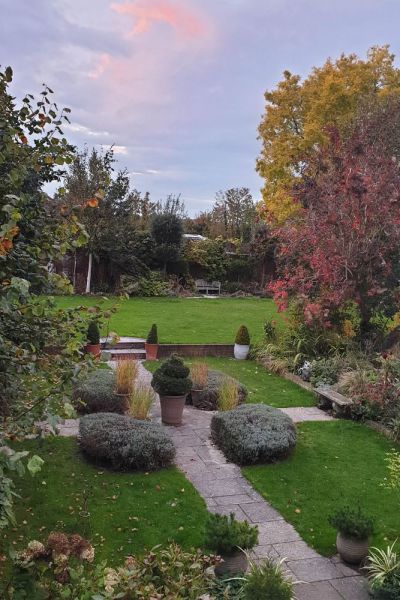
Our ‘good enough’ lawn two years ago, in November. I used to feel guilty about never doing the lawn care jobs on the gardening ‘to do’ lists, but if the lawn is looking good enough for you, then it’s good enough. You can sort out any problems when they arise.
What’s the best low maintenance lawn?
One of the lawns David Hedges Gower showed me was in a neighbour’s garden. They never use weed killer, fertiliser or moss control on it. They don’t scarify it and they don’t water it. It’s mown continuously with a battery powered robot mower which deposits the grass cuttings back on the lawn. They are reabsorbed, so they feed the lawn.
That’s probably the easiest, low maintenance lawn you can get. It won’t be striped.
A battery powered robot mower is currently considered a more environmentally friendly option than a petrol mower. (However, there are environmental issues around everything, such as lithium mining for batteries.)
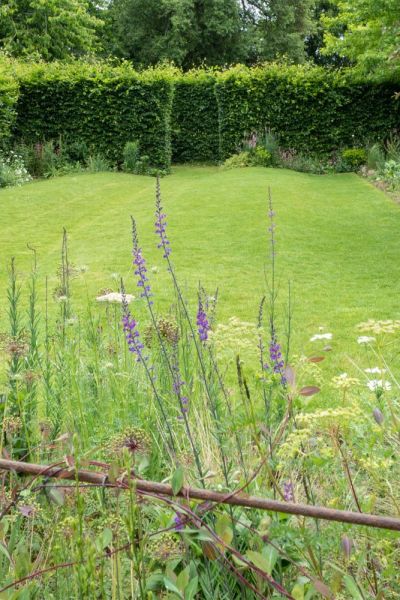
This lawn requires very little care – it’s the perfect lawn for busy people or those who don’t enjoy gardening. It’s mowed with a battery-powered robot mower, which leaves the grass clippings on the lawn to return the nutrition to the earth. Otherwise it isn’t fertilised, watered or scarified. The robot mower has coped with the uneven ground (there is some pipework).
This option is probably the lowest maintenance surface you will find for your garden.
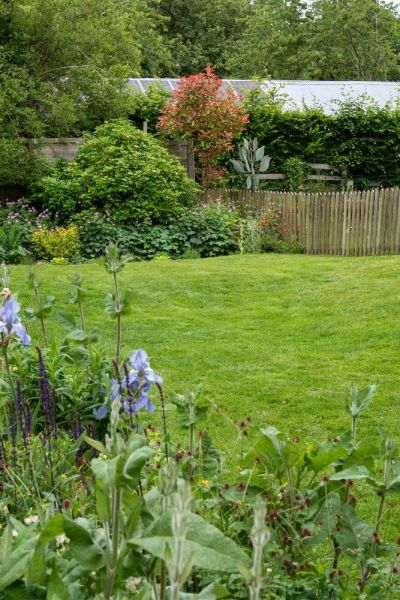
This lawn at David Hedges Gower’s home is also relatively little work. It’s mown weekly with a battery mower but isn’t otherwise treated.
Is it better to mow the lawn more often?
Frequent, regular mowing does help the lawn get thicker, says David Hedges Gower. That means that it can out-compete weeds better. ‘Grass is a plant and mowing is essentially pruning,’ he says. Just as pruning or pinching out makes plants branch out, so regular mowing can help lawn grass branch out and look more like a ‘perfect lawn’.
But, as he says, it’s all a question of what you want. If you want daisies and clover for pollinators, then it’s fine to mow the lawn once every two weeks rather than weekly.
If you subsequently want to return to a traditional green striped lawn, then you can go back to regular mowing. It will help the grass re-establish over the daisies, clover and other weeds.
In Where to Start With a Neglected Garden, Natalie and Mike Newman bought a house which had two lawns, thick with weeds, brambles and self seeded trees. They had the self seeded trees and brambles professionally cleared on one lawn, then re-seeded it.
But their front lawn still had some grass left, although it was thick with thistles. So they weeded out the thistles and kept mowing the grass weekly. It took a year, but they regained the proper lawn just by mowing and weeding.
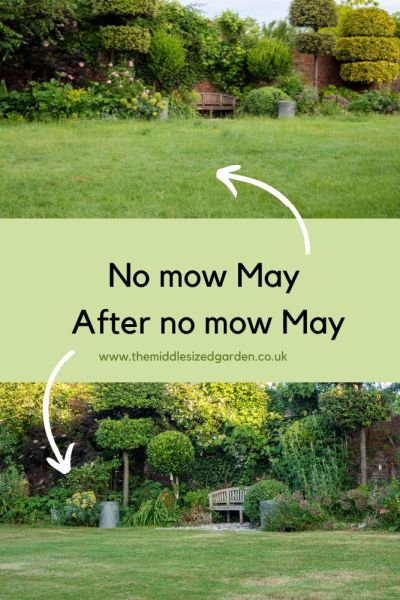
The top picture shows our lawn at the end of No Mow May when we didn’t mow it for 6 weeks. The picture below it shows it the day after mowing. It is patchy with drought – but I checked some neighbouring gardens and they, too, are have brown drought patches although they have been mown regularly.
Is artificial grass less work?
Some people are turning to artificial grass, in the hope that it will be less work and will look better. Sadly, neither is true. All surfaces in your garden (and indeed in your home) need some maintenance. Artificial grass is no exception.
Companies selling artificial grass may say that you don’t have to mow, water or weed it.
An you won’t have to mow it. But you will have to weed artificial grass and you will have to clean it – it’s effectively an outdoor carpet, so it will need washing or other cleaning methods.
If you have a water meter, artificial grass will probably cost you more in washing than watering a real lawn would. That’s because you don’t really have to water a real lawn, except in its first year. You can let it go brown and it will bounce back. However, if you live in a very dry country, you may only be able to keep a lawn going with regular irrigation. If this is the case, then a lawn may not be a good choice for your garden at all.
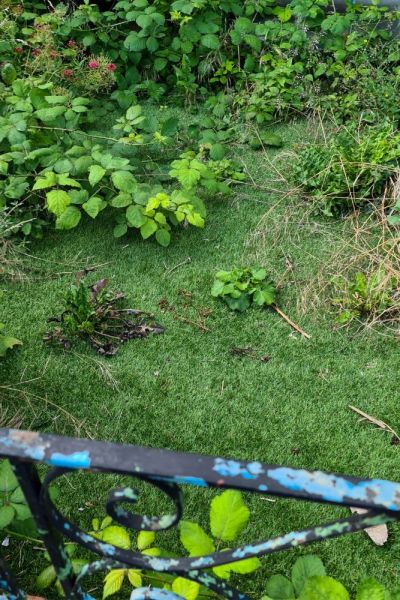
It’s hard to believe that this is artificial grass – but it is. It shows how weedy it can get if it’s not weeded at all. Other artificial grass front gardens I’ve seen are not as weedy as this, but they are weeded regularly, whereas this one has been left – for around two years, I think.
Why you have to weed and clean artificial grass
Weeds are blown through the air and land on every surface, including plastic grasses. A few also make their way up through the membrane underneath artificial grass, or around the edges. Looking at front gardens with artificial grass around me, I’d say they’re weeding about every 4-5 weeks.
In spring and autumn, blossom and leaves drop into gardens. They have to be cleared away from an artificial lawn regularly or they will cause damage. You have to clear away leaves on a traditional lawn too, but blossom is usually just absorbed.
There are various ways of keeping artificial grass in good condition. Manufacturers advise regular brushing with a stiff brush, adding sand once or twice a year and/or regular washing. If you don’t keep it clean, it can get fungal infections that will create black patches. Check care instructions for any brand you are thinking of getting.
Many brands are guaranteed for ten, fifteen or twenty years, but start to fade, ruck up or curl up at the edges before that. Checking local front gardens, I can see that one is starting to ruck up after about 5 years in situ.
Artificial grass cannot be recycled and it is not wildlife friendly. It deprives birds, pollinators, worms and soil micro-organisms of an important habitat. And it is very rarely possible to recycle it, whatever the manufacturers say.
Is artificial grass expensive?
When costing out your options, it is worth remembering that artificial grass will have to be replaced, while brick, stone and other pavers last for centuries.
You’d need a personal quote for installing artificial grass but I have seen estimates of between £35-£60 a square metre. So that means £700-£1,200 to install 20 sq m of artificial turf. And you will need to re-install it at some point in the next 10 years or so.
You would pay around £500-600 for installing real turf and it won’t have to be replaced. If you sow a lawn from seed yourself, it’s about 50p a sq metre, so the 20 sq metres would cost around £10, although there may be other costs involved if you have to add new topsoil.
If you have a very small area and it’s shady, then real grass is unlikely to do well. In this case, artificial grass is one of the options, so compare the costs and maintenance with brick, stone and other pavers.
Is the perfect lawn good for the environment?
Firstly, this very much depends on where you live, and how you treat your lawn.
In the UK (and much of northern Europe and North America), the natural environment is a mix of grasslands and forest. Grass locks in carbon dioxide and has a beneficial relationship with essential plants, funghi and bacteria in the soil. Lawns absorb dust and other air pollutants, locking them into the soil so that we don’t breathe them in.
It’s also a valuable part of the cycle in terms of biodiversity (just watch birds pecking at your lawn on any day!)
Many lawns are predominantly made of native grass species, which are well adapted to flourish in our gardens without too much extra care.
Such lawns are good for the environment. As David points out, ‘grasses are plants.’ It is always better to fill our outdoor spaces with plants if we can. Almost anything else will have environmental issues of its own.
When a lawn is bad for the environment
The environmental problems arise when lawns are treated with herbicides and fertilisers in order to create the perfect lawn. They often also use too many resources if they are regularly watered and mowed with a petrol mower. All those factors together cancel out the environmental benefits of a lawn. Heavily managed lawns are not good for the environment.
But, of course, you don’t have to have all those factors together. David uses organic fertilisers (his True Grass fertiliser is a waste product of food production). He doesn’t use herbicides nor does he water his lawns. When he waters lawns for professional clients, he uses recycled ‘grey water’ where possible.
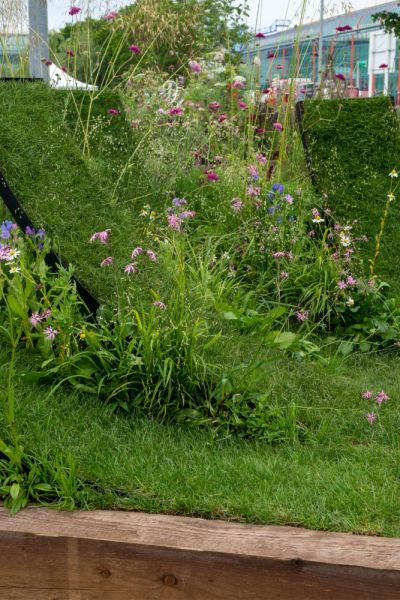
This is the ‘Green Desert’ show border at BBC Gardeners World Live, designed by Aaron Marubbi to help people question the way lawns managed. But you can have a traditional lawn that is environmentally friendly, if you know which factors are causing the problems.
But there are some parts of the world where traditional temperate climate lawn grasses should not be planted. Hotter, drier countries often have their own native grasses, but they don’t create the traditional ‘perfect lawn’ effect, so a great deal of time, effort, money and resources will be used to maintain the look.
Lawns are definitely bad for the environment in those circumstances. ‘Right plant, right place’ is at the heart of successful gardening. You wouldn’t try to grow palm trees up a mountain in Scotland, so don’t try to create a traditional English lawn in Florida.
You won’t have a smooth evenly green sward unless you do at least some of the lawn care suggestions in the gardening ‘to do’ lists. But you don’t have to do them all. And you don’t have to have a perfect lawn, only the perfect lawn for you.
See the video with lawn advice
You can see more of the interview with David Hedges-Gower and more examples of the lawns in video here.
Pin to remember imperfect and perfect lawn tips
And see here if you’d like a free weekly email with tips, ideas and inspiration for your garden.
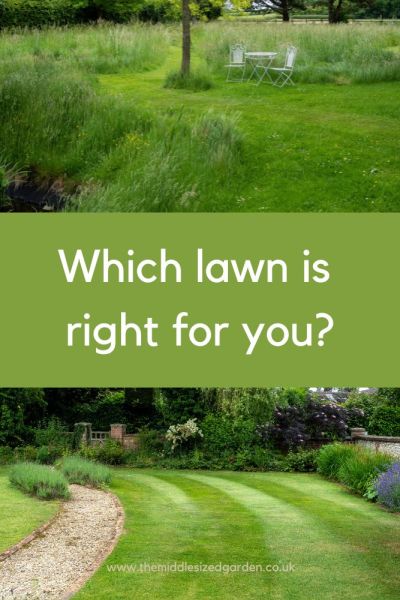

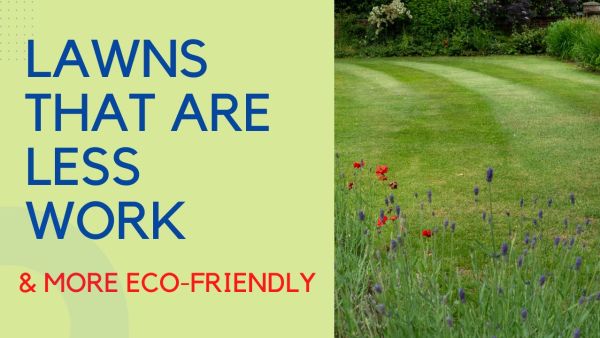























Having just bought our first place with a garden, complete with a very sad, patchy, ivy and bramble-filled lawn, this was a really helpful article and is definitely going to be a reference guide when we’re deciding what to do with it. We’re definitely keen to encourage birds and bugs (and we’re not too keen on mowing either!)
Good luck and I hope it will give you lots of pleasure (it will!).
Many thanks for your weekly blog, it has helped guide me through my first two years of gardening with many practical tips and lots of inspiration. I do have a quick question: have you ever had to deal with creeping cinquefoil invading a lawn? It’s everywhere in my garden. With a lot of effort I can keep it down in the flower beds but I really don’t know what to do about it being in the lawn.
When I asked David Hedges Gower about weeds in lawn, he said that regular mowing generally makes the grass grow stronger so it outcompetes the weeds. But I’ve had a look at creeping cinquefoil online and it seems as if a lawn herbicide may be the only option. I very rarely use weedkillers myself but I think this may be a case for an exception.
I am sick of woke gardening programmes and articles. When you stated that you attended the BBC Gardeners World exhibition it said it all. The most interesting gardening story this year was the People’s Choice of top garden at Chelsea. Monty Don dismissed the vote with such arrogance and disgust.
Just shows how out of touch the woke gardening presenters are with the general public.
Funny how all the public’s choices revolve around a lovely lawn which you and the likes of the culture warriors are trying to belittle.
Yes, I agree that the People’s Choice garden at Chelsea was beautiful. It should have had a Gold medal as well.